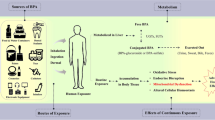Abstract
Objectives: Although the genotoxicity related to waste anaesthetic gases is controversial, a consistent number of observations have provided evidence for an increased level of DNA strand breaks. The goal of the research was to investigate this hypothesis and estimate the genoprotective role of antioxidant supplementation in technical anaesthesiology staff working in operating theatres. Methods: Heparinized venous blood samples were collected from 17 exposed technical anaesthesiology staff (mean age 34.3 ± 3.5 years) and non-exposed control group (mean age 32.2 ± 3.4 years) and examined in the alkaline comet assay for DNA strand breakage. Vitamin E (300 mg/day) plus vitamin C (500 mg/day) were supplemented to the technical anaesthesiology staff for 12 weeks and blood samples were retaken and evaluated by comet assay. Results: The DNA breakage observed in the lymphocytes of the technical anaesthesiology staff was 21.5 ± 5.0, as calculated by total comet score (TCS). This score was significantly higher (P < 0.001) than in the controls (8.6 ± 4.7) before antioxidant treatment. Supplementation of vitamins E plus C significantly (P < 0.01) reduced the mean TCS as 14.2 ± 6.1. Conclusion: The results of our study indicate that occupational exposure to anaesthetic gases induces oxidative DNA damage. Supplementation of the diet for 12 weeks with vitamin C and vitamin E resulted in a significant decrease in the DNA damage.

Similar content being viewed by others
References
Anderson D (2001) Factors that contribute to biomarker responses in humans including a study in individuals taking vitamin C supplementation. Mutat Res 480–481:337–347
Bigatti P, Lamberti L, Ardito G, Armellino F, Malanetto C (1985) Chromosome aberrations and sister chromatid exchanges in occupationally exposed workers. Med Lav 76:334–339
Bilban M, Jakopin CB, Ogrinc D (2005) Cytogenetic tests performed on operating room personnel (the use of anaesthetic gases). Int Arch Occup Environ Health 78:60–64
Bozkurt G, Memis D, Karabogaz G, Pamukcu Z, Ture M, Karamanlioglu B, Gunday I, Algunes C (2002) Genotoxicity of waste anaesthetic gases. Anaesth Intensive Care 30:597–602
Chang WP, Lee S, Tu J, Hseu S (1996) Increased micronucleus formation in nurses with occupational nitrous oxide exposure in operating theaters. Environ Mol Mutagen 27:93–97
Collins AR (2002) The comet assay. Principles, applications, and limitations. Methods Mol Biol 203:163–177
Collins AR (2004) The comet assay for DNA damage and repair: principles, applications, and limitations. Mol Biotechnol 26(3):249–261
Duthie SJ, Ma A, Ross MA, Collins AR (1996) Antioxidant supplementation decrease oxidative DNA damage in human lymphocytes. Cancer Res 56:1291–1295
Halliwell B, Gutteridge JMC (1999) Free radicals in biology and medicine, 3rd edn. Oxford University press, New York
Heavner JE (2003) Toxicity of anaesthetics. Best Pract Res Clin Anaesthesiol 17:1–3
Husum B, Wulf HC (1980) Sister chromatid exchanges in lymphocytes in operating room personnel. Acta Anaesthesiol Scand 24:22–24
Husum B, Niebuhr E, Wulf HC, Norgaard I (1983) Sister chromatid exchanges and structural chromosome aberrations in lymphocytes in operating room personnel. Acta Anaesthesiol Scand 27:262–265
Karabiyik L, Şardaş S, Polat U, Kocabas NA, Karakaya AE (2001) Comparison of genotoxicity of sevoflurane and isoflurane in human lymphocytes studied in vivo using the comet assay. Mutat Res 492:99–107
Kassie F, Parzefall W, Knasmuller S (2000) Single cell gel electrophoresis assay: a new technique for human biomonitoring studies. Mutat Res 463:13–31
Lewinska D, Stepnik M, Krajewski W, Arkusz J, Stanczyk M, Wronska-Nofer T (2005) Increased incidence of micronuclei assessed with the micronucleus assay and the fluorescence in situ hybridization (FISH) technique in peripheral blood lymphocytes of nurses exposed to nitrous oxide. Mutat Res 581(1–2):1–9
Mayne ST (2003) Antioxidant nutrients and chronic disease: use of biomarkers of exposure and oxidative stress status in epidemiologic research. J Nutr 133:933–940
Miller AB (1990) Diet and cancer. Rev Oncol 3:87–95
NIOSH National Institute for Occupational Safety and Health (1977) Criteria for a recommended standard: occupational exposure to anesthetic gases and vapors, publication no: 770140. US Department of Health, Education and Welfare (DHEW), Cincinnati
Rozgaj R, Kasuba V, Jazbec A (2001) Preliminary study of cytogenetic damage in personnel exposed to anesthetic gases. Mutagenesis 16(2):139–143
Sardas S (2003) The role of antioxidants in cancer prevention and treatment. Indoor Built Environ 125:401–404
Sardas S, Cuhruk H, Karakaya AE, Atakurt Y (1992) Sister chromatid exchanges in operating room personnel. Mutat Res 279:117–120
Sardas S, Aygun N, Gamli M, Unal Y, Berk N, Karakaya AE (1998a) Use of alkaline comet assay (single cell gel electrophoresis technique) to detect DNA damages in lymphocytes of operating room personnel occupationally exposed to anaesthetic gases. Mutat Res 418:93–100
Sardas S, Karabiyik L, Aygün N, Karakaya AE (1998b) DNA damage evaluated by the alkaline comet assay in lymphocytes of humans anaesthetized with isoflurane. Mutat Res 418:1–6
Sessler DI (1997) Risks of occupational exposure to waste-anesthetic gases. Acta Anaesthesiol Scand Suppl 111:237–239
Singh NP, Mc Coy MT, Tice RR, Schneider EL (1988) A simple technique for quantitation of low levels of DNA damage in individual cells. Exp Cell Res 175:184–191
Tice RR, Agurell E, Anderson D, Burlinson B, Hartmann A, Kobayashi H, Miyamae Y, Rojas E, Ryu JC, Sasaki YF (2000) Single cell gel/comet assay: guidelines for in vitro and in vivo genetic toxicology testing. Environ Mol Mutagen 35(3):206–221
Wiesner G, Hoerauf K, Schroegendorfer K, Sobczynski P, Harth M, Ruediger HW (2001) High-level, but not low-level, occupational exposure to inhaled anesthetics is associated with genotoxicity in the micronucleus assay. Anesth Analg 92:118–122
Acknowledgements
We wish to thank all the technical anaesthesiology staff and the controls who volunteered to participate and Roche for supplying the vitamins E and C.
Author information
Authors and Affiliations
Corresponding author
Rights and permissions
About this article
Cite this article
Sardas, S., Izdes, S., Ozcagli, E. et al. The role of antioxidant supplementation in occupational exposure to waste anaesthetic gases. Int Arch Occup Environ Health 80, 154–159 (2006). https://doi.org/10.1007/s00420-006-0115-6
Received:
Accepted:
Published:
Issue Date:
DOI: https://doi.org/10.1007/s00420-006-0115-6




